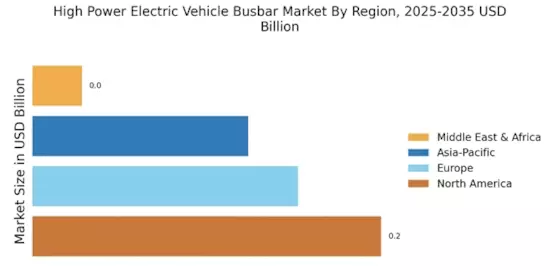Regulatory Support and Incentives
The High Power Electric Vehicle Busbar Market is benefiting from a favorable regulatory environment that promotes the adoption of electric vehicles. Governments worldwide are implementing policies and incentives aimed at reducing carbon emissions and encouraging the transition to electric mobility. These initiatives often include subsidies for electric vehicle purchases, tax breaks for manufacturers, and funding for charging infrastructure development. Such regulatory support not only stimulates demand for electric vehicles but also necessitates the development of efficient power distribution systems, including busbars. As regulations become more stringent regarding emissions and energy efficiency, the market for high power busbars is likely to expand, driven by the need for compliance and innovation in the High Power Electric Vehicle Busbar Market.
Growing Focus on Energy Efficiency
The High Power Electric Vehicle Busbar Market is increasingly shaped by a growing focus on energy efficiency within the transportation sector. As electric vehicles become more prevalent, the need for efficient energy transfer systems becomes paramount. Busbars play a critical role in minimizing energy losses during power distribution, which is essential for maximizing the performance of electric vehicles. Recent studies suggest that optimizing busbar design can lead to significant improvements in energy efficiency, potentially reducing operational costs for manufacturers and consumers alike. This emphasis on energy efficiency aligns with broader sustainability goals, further driving the demand for advanced busbar solutions in the High Power Electric Vehicle Busbar Market. As stakeholders prioritize energy-efficient technologies, the market is poised for growth.
Expansion of Charging Infrastructure
The High Power Electric Vehicle Busbar Market is poised for growth due to the ongoing expansion of charging infrastructure. As electric vehicle adoption accelerates, the need for a robust and efficient charging network becomes increasingly critical. Investments in charging stations, particularly fast-charging solutions, are on the rise, necessitating the integration of high power busbars to facilitate rapid energy transfer. Recent reports indicate that the number of charging stations is expected to increase significantly in the coming years, driven by both public and private sector initiatives. This expansion not only supports the growing electric vehicle market but also creates opportunities for innovation in busbar technology. As charging infrastructure evolves, the High Power Electric Vehicle Busbar Market is likely to experience enhanced demand for advanced solutions that meet the needs of modern electric vehicles.
Increasing Electric Vehicle Adoption Rates
The High Power Electric Vehicle Busbar Market is significantly influenced by the increasing adoption rates of electric vehicles across various regions. As consumers and businesses alike shift towards electric mobility, the demand for efficient power distribution systems, such as busbars, is expected to rise. Recent data indicates that electric vehicle sales have seen a substantial increase, with projections suggesting that by 2025, electric vehicles could account for a considerable percentage of total vehicle sales. This trend is likely to drive investments in infrastructure, including charging stations and power distribution systems, thereby bolstering the High Power Electric Vehicle Busbar Market. The growing consumer preference for sustainable transportation solutions further amplifies this demand, indicating a robust future for busbar technologies.
Technological Innovations in Busbar Design
The High Power Electric Vehicle Busbar Market is experiencing a surge in technological innovations that enhance the efficiency and performance of busbars. Advanced materials, such as lightweight composites and high-conductivity metals, are being utilized to improve thermal management and reduce weight. This is particularly crucial as electric vehicles demand higher power levels for rapid charging and efficient energy transfer. The integration of smart technologies, including sensors and monitoring systems, allows for real-time performance tracking, which can lead to improved safety and reliability. As manufacturers continue to innovate, the market is likely to see a rise in the adoption of these advanced busbar designs, which could potentially lead to a more competitive landscape in the High Power Electric Vehicle Busbar Market.


















Leave a Comment